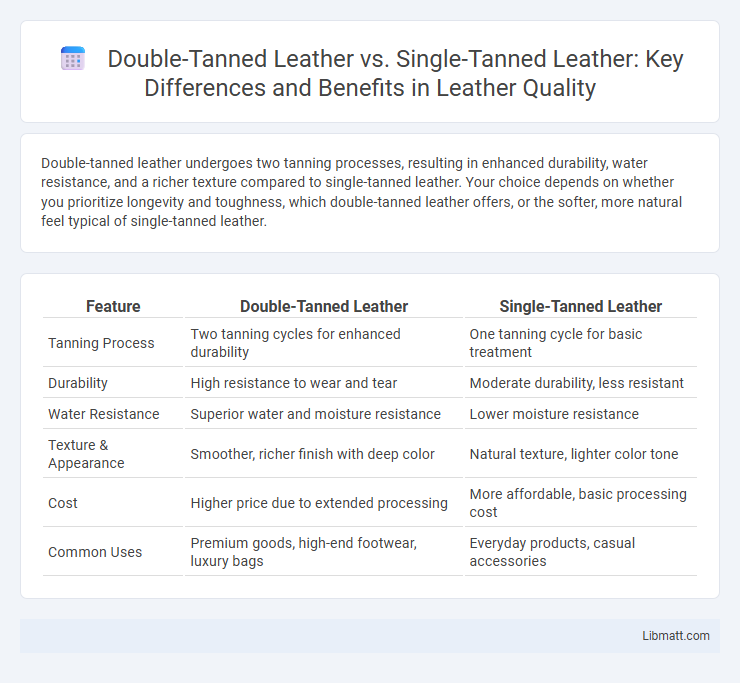Double-tanned leather undergoes two tanning processes, resulting in enhanced durability, water resistance, and a richer texture compared to single-tanned leather. Your choice depends on whether you prioritize longevity and toughness, which double-tanned leather offers, or the softer, more natural feel typical of single-tanned leather.
Table of Comparison
| Feature | Double-Tanned Leather | Single-Tanned Leather |
|---|---|---|
| Tanning Process | Two tanning cycles for enhanced durability | One tanning cycle for basic treatment |
| Durability | High resistance to wear and tear | Moderate durability, less resistant |
| Water Resistance | Superior water and moisture resistance | Lower moisture resistance |
| Texture & Appearance | Smoother, richer finish with deep color | Natural texture, lighter color tone |
| Cost | Higher price due to extended processing | More affordable, basic processing cost |
| Common Uses | Premium goods, high-end footwear, luxury bags | Everyday products, casual accessories |
Introduction to Leather Tanning Processes
Double-tanned leather undergoes two distinct tanning treatments, enhancing durability, water resistance, and longevity compared to single-tanned leather, which only receives one tanning process. The initial tanning stabilizes the rawhide by converting collagen fibers, while the second tanning further refines texture, strength, and color depth, often involving different tanning agents like vegetable extracts or chrome salts. These processes impact the final leather quality, making double-tanned leather preferable for heavy-duty applications and premium products requiring superior resilience.
What is Single-Tanned Leather?
Single-tanned leather undergoes a single tanning process where raw animal hides are treated with tannins to convert them into durable, flexible leather. This method preserves the natural texture and grain of the hide, resulting in a soft yet sturdy material suitable for various leather goods. Understanding single-tanned leather helps you appreciate its simpler production process and the unique characteristics it brings to finished products.
What is Double-Tanned Leather?
Double-tanned leather undergoes two distinct tanning processes, enhancing its durability, water resistance, and texture compared to single-tanned leather, which is treated only once. This method typically combines vegetable tanning followed by chrome tanning, resulting in a thicker, more robust material ideal for products like high-end footwear and luxury bags. Understanding the benefits of double-tanned leather can help you choose premium leather goods with superior longevity and aesthetic appeal.
Key Differences Between Single and Double Tanning
Double-tanned leather undergoes a second tanning process that significantly enhances its durability, water resistance, and overall strength compared to single-tanned leather, which is treated only once. The double tanning method typically uses different tanning agents in each stage, improving the leather's texture, longevity, and ability to resist wear and tear. Single-tanned leather retains a softer, more flexible feel but is generally less robust, making double-tanned leather ideal for high-use items like boots and saddles.
Durability: Double-Tanned vs Single-Tanned Leather
Double-tanned leather offers significantly enhanced durability compared to single-tanned leather due to the extended tanning process that increases its resistance to wear, moisture, and environmental factors. Single-tanned leather, while still sturdy, tends to be more prone to cracking and degradation over time, especially under heavy use. The second tanning stage in double-tanned leather strengthens the fibers, providing superior longevity and making it ideal for high-stress applications such as footwear and heavy-duty accessories.
Texture and Appearance Comparison
Double-tanned leather features a richer, more uniform texture with enhanced durability and deeper color saturation compared to single-tanned leather, which often exhibits a softer, more natural surface with visible grain variations. The double tanning process intensifies the leather's appearance, resulting in a smoother, glossier finish that retains its quality over time. In contrast, single-tanned leather provides a matte, more organic look that highlights the natural imperfections and unique characteristics of the hide.
Water and Stain Resistance
Double-tanned leather offers superior water and stain resistance compared to single-tanned leather due to its extended tanning process, which enhances the leather's durability and ability to repel moisture. The additional tanning stage strengthens the leather fibers, making it less prone to absorption and easier to clean, ideal for environments with frequent exposure to water or dirt. Choosing double-tanned leather ensures your items maintain their quality and appearance longer, providing better protection against spills and stains.
Common Uses for Each Leather Type
Double-tanned leather is commonly used for high-durability items such as saddles, heavy-duty boots, and industrial gloves due to its enhanced toughness and resistance to wear. Single-tanned leather finds frequent application in lighter products like handbags, wallets, and apparel, offering a softer texture and more flexibility. Your choice depends on whether you prioritize strength and longevity or comfort and style in leather goods.
Cost and Value Analysis
Double-tanned leather typically costs 20-30% more than single-tanned leather due to the extended processing time and additional resources required for enhanced durability and improved texture. The increased investment is justified by double-tanned leather's superior resistance to wear, making it a more valuable option for luxury goods and long-lasting products. While single-tanned leather remains affordable and suitable for everyday use, double-tanned leather offers higher value through enhanced quality and extended product lifespan.
Which Leather Should You Choose?
Double-tanned leather offers enhanced durability and water resistance compared to single-tanned leather, making it ideal for heavy-use items such as boots and outdoor gear. Single-tanned leather retains a softer texture and is more flexible, suitable for fashion accessories like handbags and jackets where comfort and aesthetics are prioritized. Choosing between them depends on the intended use: opt for double-tanned leather for longevity and rough conditions, while single-tanned leather is best for style and everyday wear.
Double-tanned leather vs single-tanned leather Infographic

 libmatt.com
libmatt.com